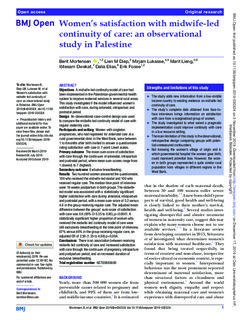| dc.contributor.author | Mortensen, Berit | |
| dc.contributor.author | Diep, Lien My | |
| dc.contributor.author | Lukasse, Mirjam | |
| dc.contributor.author | Lieng, Marit | |
| dc.contributor.author | Dwekat, Ibtesam | |
| dc.contributor.author | Elias, Dalia | |
| dc.contributor.author | Fosse, Erik | |
| dc.date.accessioned | 2020-01-15T12:33:16Z | |
| dc.date.available | 2020-01-15T12:33:16Z | |
| dc.date.created | 2019-12-12T15:08:28Z | |
| dc.date.issued | 2019 | |
| dc.identifier.citation | BMJ Open. 2019, 9 (11), 1-9. | nb_NO |
| dc.identifier.issn | 2044-6055 | |
| dc.identifier.uri | http://hdl.handle.net/11250/2636424 | |
| dc.description | This is an open access article distributed in accordance with the Creative Commons Attribution Non Commercial (CC BY-NC 4.0) license, which permits others to distribute, remix, adapt, build upon this work non-commercially, and license their derivative works on different terms, provided the original work is properly cited, appropriate credit is given, any changes made indicated, and the use is non-commercial | nb_NO |
| dc.description.abstract | Abstract Objectives A midwife-led continuity model of care had been implemented in the Palestinian governmental health system to improve maternal services in several rural areas. This study investigated if the model influenced women’s satisfaction with care, during antenatal, intrapartum and postnatal period. Design An observational case-control design was used to compare the midwife-led continuity model of care with regular maternity care. Participants and setting Women with singleton pregnancies, who had registered for antenatal care at a rural governmental clinic in the West Bank, were between 1 to 6 months after birth invited to answer a questionnaire rating satisfaction with care in 7-point Likert scales. Primary outcome The mean sum-score of satisfaction with care through the continuum of antenatal, intrapartum and postnatal period, where mean sum-scores range from 1 (lowest) to 7 (highest). Secondary outcome Exclusive breastfeeding. Results Two hundred women answered the questionnaire, 100 who received the midwife-led model and 100 who received regular care. The median time point of interview were 16 weeks postpartum in both groups. The midwife-led model was associated with a statistically significant higher satisfaction with care during antenatal, intrapartum and postnatal period, with a mean sum-score of 5.2 versus 4.8 in the group receiving regular care. The adjusted mean difference between the groups’ sum-score of satisfaction with care was 0.6 (95% CI 0.35 to 0.85), p<0.0001. A statistically significant higher proportion of women who received the midwife-led continuity model of care were still exclusively breastfeeding at the time point of interview, 67% versus 46% in the group receiving regular care, an adjusted OR of 2.56 (1.35 to 4.88) p=0.004. Conclusions There is an association between receiving midwife-led continuity of care and increased satisfaction with care through the continuum of pregnancy, intrapartum and postpartum period, and an increased duration of exclusive breastfeeding. | nb_NO |
| dc.language.iso | eng | nb_NO |
| dc.rights | Navngivelse-Ikkekommersiell 4.0 Internasjonal | * |
| dc.rights.uri | http://creativecommons.org/licenses/by-nc/4.0/deed.no | * |
| dc.title | Women's satisfaction with midwife-led continuity of care: An observational study in Palestine | nb_NO |
| dc.type | Journal article | nb_NO |
| dc.type | Peer reviewed | nb_NO |
| dc.description.version | publishedVersion | nb_NO |
| dc.rights.holder | © Author(s) (or their employer(s)) 2019. | nb_NO |
| dc.source.pagenumber | 9 | nb_NO |
| dc.source.volume | 9 | nb_NO |
| dc.source.journal | BMJ Open | nb_NO |
| dc.source.issue | 11 | nb_NO |
| dc.identifier.doi | 10.1136/bmjopen-2019-030324 | |
| dc.identifier.cristin | 1760156 | |
| cristin.unitcode | 222,56,0,0 | |
| cristin.unitname | Fakultet for helse- og sosialvitenskap | |
| cristin.ispublished | true | |
| cristin.fulltext | original | |
| cristin.qualitycode | 1 | |

